City Directories and History: This mill, which has operated under many names, was the first textile mill in Rock Hill. Developed by James M. Ivy and Adolphus
Eugene Hutchison, the mill was completed in 1881. (For additional information see R&R’s pages for the RH Cotton Factory #1)Other initial investors in the mill were Rock Hill businessmen Andrew Hutchison White, William Lyle Roddey, William Barron Fewell, John Rutherford London, and Allen Jones. Other investors included J. I. Middleton, W. G. Atkinson, and Hiram Hutchison. The mill was constructed by A.
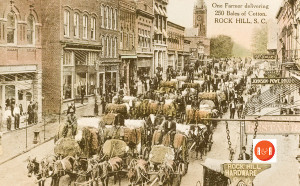
Image courtesy of the Allen Postcard Collection – R&R
D. Holler and R. H. Morse, and was based on the Camperdown Mill in Greenville. However, where the Camperdown Mill was located on the Reedy River and used water power, the Rock Hill Cotton factory was the first stream-powered mill in South Carolina.
The location of the mill was chosen because it was on the Charlotte, Columbia, and Augusta Railroad. Within a few years the “Three C’s” railroad was built nearby, giving access to two lines. When the mill began operation, it had 3,000 spindles with 40 laborers, mostly women and children, and produced yarn. By 1882, the mill had increased operations to 7,904 spindles and 100 employees. Mill housing was also developed in the early years. An expansion took place in 1894, after which the mill began weaving cloth, producing shirtings, sheetings, and drills.
In the late 1890s, problems with the cotton crop and problems in the mill led to the failure of the company. In 1899, ownership was transferred to W. C. Hutchison and A. H. White, who obtained a new charter under the name Crescent Cotton Mill. This company was unable to operate profitably, and went through several reorganizations, operating as Crescent Cotton Mills under new owners from 1900 to 1904 and as Chicora Mill from 1904 to 1905. At this point, it was purchased by Detroit textile leader Hamilton Carhartt. He converted the mill to electric power, available from the new India Hook Dam. Carhartt was successful in making the Rock Hill mill a major source for manufacturing denim for overalls. The Carhartt corporation was the world’s largest
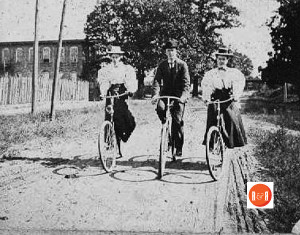
Cycling along Chatham Avenue near the Depot. Courtesy of the White – Presto Collection, Pettus Archives Collection at Winthrop University. Note the Rock Hill Cotton Mill is in the background.
manufacturer of work gloves and overalls, and the Rock Hill operation became an important part of his textile empire. Within a few years, he expanded the plant with a three story annex and dying room and had built a second mill at Red River. Carhartt also built a home on a farm near the Red River mill, and spent a good deal of time in the Rock Hill area. The mill was very profitable during the teens and World War I. However, a global recession in 1921 forced Carhartt to close the Rock Hill mills, and in 1925, he was forced to hand them over to John H. Cutter of Charlotte, to whom he had significant debts. The Rock Hill factory became known as Cutter Manufacturing Company, and flourished for a number of years manufacturing denim and ticking. Cutter had significant business with the military during World War II, but following the war, he was forced to put it up for sale in 1946.
The mill operated as Gold-Tex Fabrics for 17 years. For two years, it was operated as a knit plant by Sol and Edward Aberman. The Ostrow Textile Company purchased the mill in 1968 and moved its operations and headquarters to the site. It was used during this period for warehousing and an outlet shop. Ostrow closed the site in 2000, and the Rock Hill Economic Development Corporation acquired it for the purposes of redevelopment. In 2006, the old mill complex was purchased by Williams & Fudge, a Rock Hill-based student loan collection company. The buildings were completely renovated and converted to retail and office uses.
The mill village for the Rock Hill Cotton Factory included homes on Adams Street, North Wilson Street from East Main to Peachtree Street, Buena Vista, Village Way, and Welfare Place. Many of the houses were built around 1907-1908 and had running water and electricity. A few scatted homes remain from this village.
Contributed and written by Paul M. Gettys – 2014
Sources: The Herald, various issues, Lynn Willoughby, The Good Town Does Well, Rock Hill, S. C., 1852-2002, published 2002 by the Rock Hill Sesquicentennial Committee, Douglas Summers Brown, The City Without Cobwebs, A History of Rock Hill, South Carolina, Columbia: University of South Carolina Press, 1953, Michael C. Scoggins, “A History of the Rock Hill Cotton Factory,” pamphlet produced for the dedication of a historical marker at the site on September 6, 2007.
ADDITION INFORMATION ON EARLY ROCK HILL HISTORY:
Article by Louise Pettus printed in the York Observer November 5, 1989
Old accounts often call James Morrow Ivy the “Father of Rock Hill.” It seems strange that there is no marker, no street, no park or anything else to commemorate his memory in the town where he had such impact in the latter part of the 19th century.
Actually, there was once a small park at Charlotte Avenue and Cedar Street named for him but somehow the name got changed over the years. Ironically, he donated the land for this park, a small triangle dominated by children’s playground equipment.
Who was James Morrow Ivy? He was born on November 5, 1838, the son of Rev. Adam Ivy, founder of three Methodist churches, and Ann Morrow of Lancaster County’s Indian land. His father was a large planter with nearly 1,500 acres of land who held a major interest in Turkey head Mills, a large flour mill on the Catawba River.
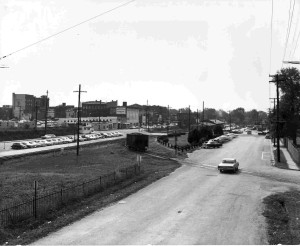
Looking toward downtown Rock Hill, along Chatham Ave., in the 1950s. Image courtesy of the Ratterree Collection.
Young Ivy was sent to Rock Hill to study under Gen. J. A. Alston, W. H. Thomasson and Col. J. M. White. The next year Alston moved to Winnsboro to head Mount Zion Academy, a distinguished school in its day. Young Ivy followed Alston but only stayed one session. He then enrolled in John R. Shurley’s school at Ebenezer, another fine preparatory school.
From Ebenezer Academy Ivy went to South Carolina College – older and better prepared than most of his classmates. He was a class leader and when the Civil War broke out became sergeant of the militia company formed by the students and several professors. Ivy witnessed the Fort Sumter bombardment.
Ivy’s company became part of Hampton’s Legion. He was badly wounded in his shoulder at the Battle of Seven Pines and never recovered the use of his left arm. Out of the army he married Ann Conner, the daughter of one of his commanding officers, and for a time managed her father’s business in Lincoln County, N. C.
When his father-in-law died in 1869, Ivy returned to Rock Hill. He established J. M. Ivy and Co. Over the year he had various partners. In 1877, he merged his firm with Fewell merchandise. Fewell concentrated on the retail market and Ivy centered his attention on an extensive fertilizer business, banking, and primarily on the buying and selling of cotton.
James Morrow Ivy is thought to have been the first Piedmont merchant to delve into the cotton futures market. According to the Yorkville Enquirer of July 10, 1879: “He began his purchases by this method as early as 1872, and has continued to study, improve, and develop his system…It is the system of selling in advance, and purchasing and selling to cover, that has enabled him to deal so largely in spot cotton, and with comparatively, perfect security…”
It was not perfect security. Eventually, Ivy lost his entire estate on the futures market in cotton. He could not control the world-wide depression and the eastern banks’ usurious rates.
It was the cotton market developed by Ivy that was the basis for the early growth of Rock Hill. Before Ivy came on the Rock Hill scene, the town’s merchants were handling about 2,000 bales annually. Within seven years, Ivy was shipping over 12,000 bales alone. The bales went north by rail.
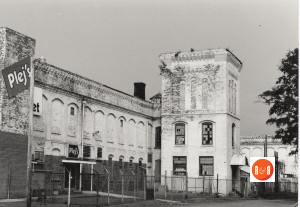
The historic Rock Hill Cotton Factory became an outlet center for Plej’s. Courtesy of the Gettys Collection.
Ivy was twice elected intendant, or mayor, of Rock Hill. If he saw a business floundering and considered it worthwhile, Ivy would buy it out, reorganize the business and get it on a safe footing. Then he would sell the business to others. He was something of a one-man economic development corporation. In this way ivy ended up owning a drug store known as Ivy & Robertson. He founded a newspaper, the Lantern, in order to have a placed to advertise his goods. Eventually, in a series of changes, the newspaper became the Herald.
Ivy initiated the drive that culminated in the establishment of the first steam engine powered mill in the upcountry, the Rock Hill Cotton Mill. He bought only a few shares of stock in the mill he organized.
Ivy was only 48 years old when he died suddenly on September 11, 1886. Looking back, we can say that the 17 years James Morrow Ivy spent in Rock Hill were a key factor in the town’s economic development.

Courtesy of the WU Pettus Archives – 2024
Click here to return to the RH Cotton Factory’s main page.
Stay Connected
Explore history, houses, and stories across S.C. Your membership provides you with updates on regional topics, information on historic research, preservation, and monthly feature articles. But remember R&R wants to hear from you and assist in preserving your own family genealogy and memorabilia.
Visit the Southern Queries – Forum to receive assistance in answering questions, discuss genealogy, and enjoy exploring preservation topics with other members. Also listed are several history and genealogical researchers for hire.
User comments welcome — post at the bottom of this page.
Please enjoy this structure and all those listed in Roots and Recall. But remember each is private property. So view them from a distance or from a public area such as the sidewalk or public road.
Do you have information to share and preserve? Family, school, church, or other older photos and stories are welcome. Send them digitally through the “Share Your Story” link, so they too might be posted on Roots and Recall.
Thanks!
User comments always welcome - please post at the bottom of this page.

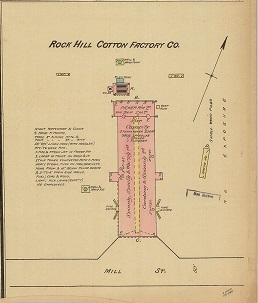


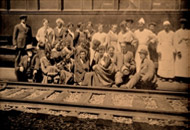
Share Your Comments & Feedback: